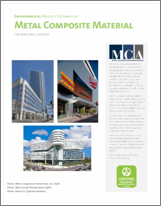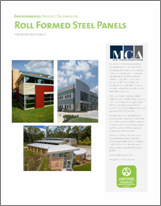 EPDs Help Assess Environmental Impact; Enable Informed Product Comparisons
EPDs Help Assess Environmental Impact; Enable Informed Product Comparisons
By Scott Kriner, AIA, LEED AP, MCA Technical Director
LEED, LCA, PCR, EPD. These aren’t just acronyms. They represent the industry’s advancements toward more energy efficient and environmentally responsible buildings. More than 15 years ago the USGBC’s Leadership in Energy and Environmental Design program initiated the movement toward improving sustainability of the built environment. As designers and building owners gradually began to realize the financial implications of wasting energy and carrying a larger environmental footprint, more attention was given to how building design can affect operating costs. That began to escalate the process of looking at all building products and their environmental impact. When AIA and other industry groups got behind the movement, it gathered speed.
 |
MCA's Environmental Product Declarations are available in the Technical Resources section of the MCA website. To visit it now, click here. |
 |
 |
When Life Cycle Assessment (LCA) first came into the picture more than 30 years ago its value was met with skepticism. That too has given way to full acceptance as LCA proved its value as a quality improvement tool with regard to environmental impact. It provides third-party verification, is internationally recognized, and offers a single, comprehensive disclosure of a product’s environmental impact throughout its life cycle. Now LCA is vital in evaluating a product’s environmental impact and in some cases getting products specified whether or not a building is being designed for LEED certification.
But that wasn’t enough. As interest in LCA information grew, the design community realized they needed more than that for true product evaluation. So LCA specialists developed a comprehensive way to simplify the overall environmental impact of a product and its related assemblies. Enter the Environmental Product Declaration (EPD). An EPD can be looked at as an executive summary of an LCA report. It shows the environmental impact of a product in specific impact categories. It also shows product conformity to the ISO 14020 series, (14020, 14021, 14024, and 14025) designed to assist businesses with measuring and communicating their efforts to minimize environmental impact.
To ensure that all EPDs meet the same requirements, LCA specialists also established a set of specific rules, requirements, and guidelines called product category rules or PCR. A single PCR can pertain to one or more product categories. For instance, the LCA study and analysis in the MCA EPDs was conducted according to the Product Category Rule (PCR) created by UL Environment for insulated metal panels, metal composite panels, and metal cladding.
Since the ISO standards are international, EPDs can be used worldwide. However many U.S. LCAs reflect the American energy grid and fuel mix. So this would need to be considered in using a U.S.-based EPD for international projects.
In addition to summarizing LCA results, EPDs contain information about product definition, building physics, the basic material and its origin, product manufacture and processing, in-use conditions, as well as testing results, and verifications. Developing an EPD requires assessing the environmental impacts throughout the lifecycle of the product, including raw material extraction, transportation, manufacturing, packaging, use, and disposal at the end of a building’s useful life. Typically, the product configurations in EPDs use ranges representative of all products in a particular industry category.
For industry-wide EPDs the information is based on specific representative products that were used in the life cycle assessment. The content of all EPD documents must be reviewed by a program operator, such as UL Environment, ICC-ES, ASTM, NSF and others, and independently verified in accordance with relevant ISO standards. An LCA practitioner performs the LCA study, and a program operator reviews all the information and arranges for the final third-party verification.
The value of EPDs in assisting purchasers and users in making informed and transparent comparisons is growing. Members of the design community are using them and the USGBC has included EPDs in LEED v4 that was introduced in 2013. International building industry groups either encourage using EPDs, offer credits for them, or require their use in some cases. These include BREEAM, FDES, the German System and the United Arab Emirates.
As an assessment tool, an EPD answers a myriad of questions in one document and offers more transparency. This allows architects and builders to easily choose products to suit each project or owner’s needs. LEED v4 encourages the use of products that have LCA information and EPDs by offering points for including a certain amount of products in a given LEED-registered project that meet these criteria.
The Metal Construction Association (MCA) has recognized the need for the metal construction industry to provide EPDs and is encouraging members to use an EPD to support the use of their products. MCA has also produced three industry-based EPDs: one for Insulated Metal Panels, another for Metal Composite Material Panels and one for Roll Formed Steel Panels for Roofs and Walls. Each of them is downloadable for free from the Metal Construction Association Web site.
For architects and contractors an EPD offers third-party verification of a product’s environmental impact in an easily accessible, single document. How each design or construction firm uses an EPD depends on what impact categories relate to a particular project design or a building owner’s needs. It’s a similar process to using a nutrition label to evaluate a food product, where each person looks at what’s most important to his or her needs. With an EPD it depends on what product attributes the team considers essential. For example, if ozone depletion potential is important, that subject is in the LCA portion of the EPD and is shown in the bar charts that have a measured level for each environmental impact category. Both this type of EPD content and identification of how products meet ISO standards are automatically raising awareness of various environmentally beneficial aspects of products in our industry. Even if a project is not aiming for LEED certification, larger architects and some contractors may require EPDs as a transparent method to describe the environmental impacts of materials used in a project specification. Many large contractors that have adopted green building practices are also driving the use of EPDs.
An EPD can also serve as a management tool for manufacturers to evaluate and change their products’ environmental impact relative to industry averages.
By developing the three current EPDs the MCA provides a valuable, convenient resource for comparing environmental values of its member’s products to other construction materials. While architects and building owners may know how well insulated metal panels, metal composite material panels, and roll-formed metal panels provide solutions for all types of buildings and identities, now they can also understand how these products meet another level of environmental performance.
Producing EPDs and promoting their use is putting the spotlight not only on environmental impact, but also on the dedication of our industry and its members to providing open, transparent, honest comparisons that go much deeper than a simple sales tool with features and benefits. We’re participating in a much higher level of third-party product evaluation that will continue to prove its value in growing the market for the use of metal in construction.
Scott Kriner, AIA, LEED AP, is the technical director for the Metal Construction Association and president and founder of Green Metal Consulting Inc. Scott can be reached by email at skriner1@verizon.net or by phone at (610) 966-2430.